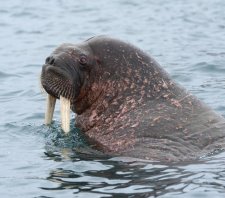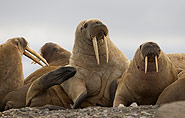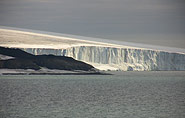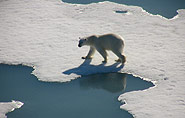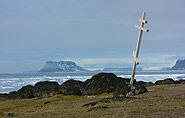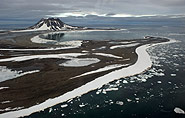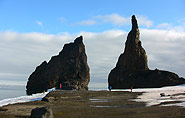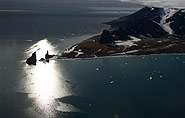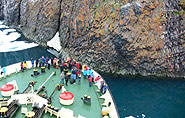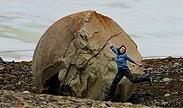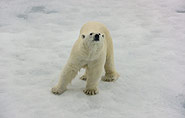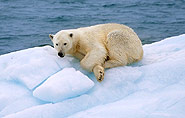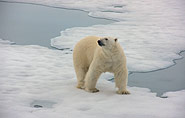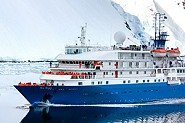polar-travel.com
Hiking, Dogsledding and Trekking tours in the Arctic (Greenland etc.)
Expedition Franz Josef Land
The Franz Josef Land archipelago is the closest land to the North Pole in the Eastern Hemisphere (about 540 miles to the North Pole from its utmost Northern point). It has been discovered in 1873 by the Austrian "Tegetthof" expedition.
Nowadays it is one of the rare 'wild' places left on earth.
The archipelago consists of 191 islands. 83% of them are covered with permanent ice. Some fifteen years ago, Russian Polar stations were working on the islands. Now they are abandoned and the whole archipelago is given back to the Wildlife. Polar Bears come to the very board of the ship, raising onto their paws and curiously staring at the people. Numerous walruses can usually be seen as well. And often the passengers are lucky to see Polar foxes, belugas and whales. And they always see lots of Arctic birds.
Nowadays it is one of the rare 'wild' places left on earth.
The archipelago consists of 191 islands. 83% of them are covered with permanent ice. Some fifteen years ago, Russian Polar stations were working on the islands. Now they are abandoned and the whole archipelago is given back to the Wildlife. Polar Bears come to the very board of the ship, raising onto their paws and curiously staring at the people. Numerous walruses can usually be seen as well. And often the passengers are lucky to see Polar foxes, belugas and whales. And they always see lots of Arctic birds.
Itinerary
1. Day:
Arrive in Longyearbyen, the administrative capital of the Spitsbergen archipelago of which West Spitsbergen is the largest island. Before embarking there is an opportunity to stroll around this former mining town, whose parish church and Polar Museum are well worth visiting. In the early evening the ship will sail out of Isfjorden.
2.- 3.. Day: At Sea
Days at sea don’t mean idleness and bore. Visit lectures and presentations of our expedition team and invited speakers. Socialize with new friends in the cozy lounge of the ship. Or be on the open decks to watch seabirds and probably whales that escort our ship.
1. Day:
Arrive in Longyearbyen, the administrative capital of the Spitsbergen archipelago of which West Spitsbergen is the largest island. Before embarking there is an opportunity to stroll around this former mining town, whose parish church and Polar Museum are well worth visiting. In the early evening the ship will sail out of Isfjorden.
2.- 3.. Day: At Sea
Days at sea don’t mean idleness and bore. Visit lectures and presentations of our expedition team and invited speakers. Socialize with new friends in the cozy lounge of the ship. Or be on the open decks to watch seabirds and probably whales that escort our ship.
4. -9. Day:
We start our visit to the Franz Josef Land Archipelago with the stop at Alexandra Land for border control procedure. The duration of the procedure depends on the authorities and can take several hours.
The next several days we will do our best to visit the different places of these fascinating, remote and hard-to-reach islands of the Russian Arctic. We need to be flexible as the weather in the Arctic usually changes several times during the day. All our activities here are strongly dependent on ice and weather conditions and safety of the passengers and the vessel are our main priority.
The list of our possible landings includes: Bell Island is named after the bell-shaped mountain, which dominates the island and is a symbol of the whole archipelago. The name was given by the British Leigh Smith Expedition. We may visit the well-preserved house built by the members of the Expedition in 1880.
We start our visit to the Franz Josef Land Archipelago with the stop at Alexandra Land for border control procedure. The duration of the procedure depends on the authorities and can take several hours.
The next several days we will do our best to visit the different places of these fascinating, remote and hard-to-reach islands of the Russian Arctic. We need to be flexible as the weather in the Arctic usually changes several times during the day. All our activities here are strongly dependent on ice and weather conditions and safety of the passengers and the vessel are our main priority.
The list of our possible landings includes: Bell Island is named after the bell-shaped mountain, which dominates the island and is a symbol of the whole archipelago. The name was given by the British Leigh Smith Expedition. We may visit the well-preserved house built by the members of the Expedition in 1880.
We hope to go on discovering the history of Arctic Exploration at Cape Flora, Northbrook Island. Here Leigh Smith and his crew had to spend 10 months after their steam yacht Eira had been crushed by ice and sunk near the coast. For 3 years – from 1894 to 1897 – the base of Frederick George Jackson British Expedition was placed at the area. The members of this expedition had made a great contribution to the exploration of the archipelago. Cape Flora is also the place where the memorable encounter of Jackson and Nansen took place. Several monuments and crosses bear witness of these historical events.
Apart from the historic sites Cape Flora is famous for its thick carpets of mosses of deep red, green and yellow. The towering cliffs at the southern part of Cape Flora are home for the huge sea birds colony. Arctic foxes are also frequent guests here.
We may visit an abandoned polar station at Tikhaya Bay on Hooker Island. The station was in function from 1929 to 1959. It was the first soviet research base and the northernmost one in the world. The site is well preserved.
Apart from the historic sites Cape Flora is famous for its thick carpets of mosses of deep red, green and yellow. The towering cliffs at the southern part of Cape Flora are home for the huge sea birds colony. Arctic foxes are also frequent guests here.
We may visit an abandoned polar station at Tikhaya Bay on Hooker Island. The station was in function from 1929 to 1959. It was the first soviet research base and the northernmost one in the world. The site is well preserved.
Tikhaya Bay is also famous for its huge cliff Rubini Rock which is a shelter for thousands of sea birds.
If we are successful at Alger Island we go on discovering the history of Arctic Exploration. We plan to visit a wintering place of the American Arctic Expedition headed by A. Baldwin. If weather permits we cruise aboard our zodiacs among drifting icebergs. Here we also have good chances for polar bears encounters.
Cape Tegetthoff at Hall Island is a favourite site for photographers: huge cliffs resembling a shark’s dorsal fins submerge in the sea. We plan a landing at the cape to watch the remains of the wooden structures built by the American Wellman Expedition of 1898-1899 aimed to reach the North Pole. We often meet polar bears at this area.
At the southern tip of Wilczek Island there is a lonely grave of the machinist Otto Krisch, who was a member of the Austro-Hungarian North Pole Expedition of Payer and Weyprecht. The expedition had failed in conquering the Pole but accidentally discovered the unknown land, which they named Franz Josef Land.
If we are successful at Alger Island we go on discovering the history of Arctic Exploration. We plan to visit a wintering place of the American Arctic Expedition headed by A. Baldwin. If weather permits we cruise aboard our zodiacs among drifting icebergs. Here we also have good chances for polar bears encounters.
Cape Tegetthoff at Hall Island is a favourite site for photographers: huge cliffs resembling a shark’s dorsal fins submerge in the sea. We plan a landing at the cape to watch the remains of the wooden structures built by the American Wellman Expedition of 1898-1899 aimed to reach the North Pole. We often meet polar bears at this area.
At the southern tip of Wilczek Island there is a lonely grave of the machinist Otto Krisch, who was a member of the Austro-Hungarian North Pole Expedition of Payer and Weyprecht. The expedition had failed in conquering the Pole but accidentally discovered the unknown land, which they named Franz Josef Land.
At Cape Heller on Wilczek Land there are the remains of the Wellman Expedition’s supply base. In 1898 two members of the expedition stayed here to secure the base. In 1899 one of them died here and was buried at the cape. As everywhere on Franz Josef Land we are very likely to witness polar bears and sea mammals during our landing.
If we succeed in reaching the Cape Fligely on Rudolf Island we will get to the northernmost point of our expedition and…of the Eastern Hemisphere. There are some historic crosses at the area. Enjoy glacial landscapes and ivory gulls’ sites.
At Stolichki and Appolonova isles we hope to observe walrus grounds. The site counted more than 600 of Atlantic walruses is unique. We patrol the coasts aboard our zodiacs and the animals often come close to our boats. Here we also may watch ivory gulls.
If we succeed in reaching the Cape Fligely on Rudolf Island we will get to the northernmost point of our expedition and…of the Eastern Hemisphere. There are some historic crosses at the area. Enjoy glacial landscapes and ivory gulls’ sites.
At Stolichki and Appolonova isles we hope to observe walrus grounds. The site counted more than 600 of Atlantic walruses is unique. We patrol the coasts aboard our zodiacs and the animals often come close to our boats. Here we also may watch ivory gulls.
Cape Norway at Jackson Island is a place where the famous Norwegian explorers Fridtjof Nansen and Hjalmar Johansen wintered in 1895-96 after failing to reach the North Pole. Their hut still remains here. Polar bears often roam nearby. Near the coasts we often encounter narwhals and beluga whales.
Champ – most say – is the most beautiful island of the archipelago. The landscape of Champ is awesome: on the ice-capped cliffs, which are the highest on Franz Josef Land, thousands of birds find their shelter. Red, yellow and green mosses contrast dramatically with white and blue of the nearby glaciers. At Champ we discover the unique nature phenomenon: the stones of regular spherical shape from 3 mm to 3 m in diameter.
Champ – most say – is the most beautiful island of the archipelago. The landscape of Champ is awesome: on the ice-capped cliffs, which are the highest on Franz Josef Land, thousands of birds find their shelter. Red, yellow and green mosses contrast dramatically with white and blue of the nearby glaciers. At Champ we discover the unique nature phenomenon: the stones of regular spherical shape from 3 mm to 3 m in diameter.
10. - 11. Day:
On the way back to Longyearbyen.The lectures of our invited speakers prepare us for meeting with the unique Arctic wildlife and awesome landscapes of Spitsbergen.
On the way back to Longyearbyen.The lectures of our invited speakers prepare us for meeting with the unique Arctic wildlife and awesome landscapes of Spitsbergen.
12. 13.. Day:
Exploring Spitsbergen For the next 2 days we are planning to explore Spitsbergen. All our activities strongly depend on ice and weather conditions. Among the places we can visit are: Ny Ålesund, Krossfjorden, Glacier of 14th of July, Signehamna, Lillehoekbreen, St. Jonsfjorden and Alkehornet.
Exploring Spitsbergen For the next 2 days we are planning to explore Spitsbergen. All our activities strongly depend on ice and weather conditions. Among the places we can visit are: Ny Ålesund, Krossfjorden, Glacier of 14th of July, Signehamna, Lillehoekbreen, St. Jonsfjorden and Alkehornet.
14. Day:
Our adventures finish in the port of Longyearbyen. Disembarkation in the morning is followed by the transfer to the airport and the flight to Oslo and home.
Our adventures finish in the port of Longyearbyen. Disembarkation in the morning is followed by the transfer to the airport and the flight to Oslo and home.
Notes:
The itinerary above is just a suggestion. The actual ice- and weather-conditions might - for safety reasons - result in a change of the scheduled program.
Explore the polar regions in style and comfort aboard our all-suite ship Sea Spirit. Providing spacious suites for accommodation of maximum of 114 passengers (the smallest suite is 20 sq. meters) the Sea Spirit at the same time features maneuverability and friendly atmosphere of small ships. An ice-strengthened hull, a fleet of rubber inflatable boats for landings on wild shores, an experienced crew, and a set of retractable fin stabilizers for smoother sailing make your polar expedition really deep, unforgettable and safe.
All suites have private facilities and exterior views. Some of the suites feature private balconies for enjoying fantastic landscapes of the Arctic.
The itinerary above is just a suggestion. The actual ice- and weather-conditions might - for safety reasons - result in a change of the scheduled program.
Explore the polar regions in style and comfort aboard our all-suite ship Sea Spirit. Providing spacious suites for accommodation of maximum of 114 passengers (the smallest suite is 20 sq. meters) the Sea Spirit at the same time features maneuverability and friendly atmosphere of small ships. An ice-strengthened hull, a fleet of rubber inflatable boats for landings on wild shores, an experienced crew, and a set of retractable fin stabilizers for smoother sailing make your polar expedition really deep, unforgettable and safe.
All suites have private facilities and exterior views. Some of the suites feature private balconies for enjoying fantastic landscapes of the Arctic.
What is included:
- Group transfer to the ship on day of embarkation;
- Group transfer to airport or central location upon disembarkation;
- Shipboard accommodation in booked category;
- All scheduled landings/excursions;
- Leadership throughout the voyage by our experienced Expedition Leader & Expedition Team;
- All meals on board throughout the voyage;
- Tea and coffee station 24 hours daily;
- Expedition parka;
- A pair of rental rubber boots on loan for shore landings;
- Welcome and Farewell cocktails;
- All port fees;
- Pre-departure materials;
- Digital Voyage Log;
What is not included:
- Airfares;
- Visa and passport fees (if applicable);
- Personal Insurances;
- Emergency Evacuation Insurance to a maximum benefit of US 100,000 per person (applied for season 2016)
- Soft drinks and alcoholic beverages other than those for special events and celebrations;
- Personal expenses such as laundry and telecommunication charges;
- Staff gratuities.
Special conditions
In case fuel price increases significantly fuel surcharge may be applied.
- Group transfer to the ship on day of embarkation;
- Group transfer to airport or central location upon disembarkation;
- Shipboard accommodation in booked category;
- All scheduled landings/excursions;
- Leadership throughout the voyage by our experienced Expedition Leader & Expedition Team;
- All meals on board throughout the voyage;
- Tea and coffee station 24 hours daily;
- Expedition parka;
- A pair of rental rubber boots on loan for shore landings;
- Welcome and Farewell cocktails;
- All port fees;
- Pre-departure materials;
- Digital Voyage Log;
What is not included:
- Airfares;
- Visa and passport fees (if applicable);
- Personal Insurances;
- Emergency Evacuation Insurance to a maximum benefit of US 100,000 per person (applied for season 2016)
- Soft drinks and alcoholic beverages other than those for special events and celebrations;
- Personal expenses such as laundry and telecommunication charges;
- Staff gratuities.
Special conditions
In case fuel price increases significantly fuel surcharge may be applied.
To Foto Gallery
Further Notes:
This cruise-expedition is being organized by a Russian tour-operator, located in Moscow
Before a booking is accepted, you will have to answer a medical questionnaire about your health status.
Also observe: There are special storno-conditions after the booking confirmation, as being listed in the General Conditions..
If you are interested in this journey, kindly
Further Notes:
This cruise-expedition is being organized by a Russian tour-operator, located in Moscow
Before a booking is accepted, you will have to answer a medical questionnaire about your health status.
Also observe: There are special storno-conditions after the booking confirmation, as being listed in the General Conditions..
If you are interested in this journey, kindly


